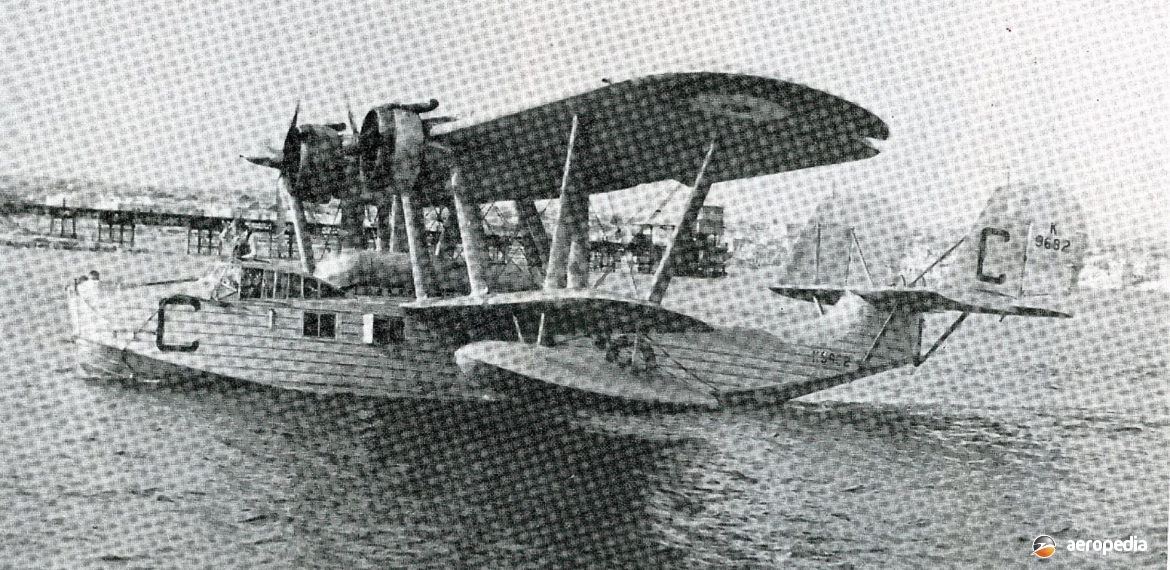Photograph:
Saunders Roe London K3560 (Eddie Coates collection)
Country of origin:
United Kingdom
Description:
Long-range general purpose patrol flying boat
Power Plant:
Two 787 kw (1,055 hp) Bristol Pegasus X nine-cylinder air-cooled radial engines
Specifications:
- [Mk II]
- Wingspan: 24.38 m (80 ft)
- Length: 17.35 m (56 ft 9½ in)
- Height: 5.76 m (18 ft 9 in)
- Wing area: 132.38 m² (1,425 sq ft)
- Max speed: 249 km/h (155 mph)
- Cruising speed: 208 km/h (129 mph)
- Initial rate of climb: 360 m/min (1,180 ft/min)
- Service ceiling: 6,066 m (19,900 ft)
- Range: 1,770 km (1,100 miles)
- Empty weight: 5,035 kg (11,000 lb)
- Loaded weight: 8,346 kg (18,400 lb)
Armament:
Three 7.69 mm (0.303 in) Lewis machine guns; bomb load comprising bombs, mines or depth charges to a max of 907 kg (2,000 lb)
History:
The London was built to a British Air Ministry specification for a general purpose coastal patrol flying boat of robust but simple construction. The prototype (K3560) was first flown in 1934. The hull was of lightweight construction with longitudinal corrugated hull skinning. The wings and tail were of stainless steel and duralumin construction with fabric covering. Normal power plant was the Bristol Pegasus III radial engine and the aircraft had a crew of five or six. The type survived after the outbreak of World War II until 1941. Total production was nine Mk Is and 38 Mk IIs. The type first entered service with No 201 Squadron at RAF Calshot replacing the Southampton and by 1938 some were based at Malta.
Following the flight of RAF Supermarine Southampton flying boats to Australia in 1928, a further flight by RAF long-range flying boats was made to this area in December 1937, these being a flight of five Saunders Roe Londons of No 203 General Reconnaissance Squadron fitted with a special long-range fuel tank above the hull. In early 1938 these aircraft (Serials K5908, K5912, K6927, K6929 and K6930) were flown to Sydney, NSW for the Sesquicentenary Celebrations. This was part of an overall return flight of 48,279 km (30,000 miles) commencing at Plymouth in the UK, being made via the Middle East, India, Rangoon, Singapore and Batavia in the Dutch East Indies. The flight was commanded by Wing Commander K B Lloyd AFC. The Sydney celebrations took place from 25 January to 7 February 1938. These five aircraft were London IIs with Pegasus X engines providing 787 kw (1,055 hp) for take-off, and differed from other aircraft in having three-blade fixed pitch propellers and long range fuel tanks increasing range to 4,184 km (2,600 miles).
Although the London has no direct link with Australasia in that it was not part of the equipment of any air force in this area, a couple of mishaps occurred when the RAF aircraft were visiting. In Sydney one (K6930) suffered a damaged hull which necessitated the aircraft being beached at Rose Bay for repairs. Also, as the formation flew over Melbourne, VIC one aircraft (K6927) lost a propeller and reduction gear, these falling over the city but not causing serious damage. The aircraft landed safely but the required extensive repairs before it was able to rejoin the other aircraft on their return to Singapore. The RAF flight later left Melbourne and flew on to Perth, WA. Eventually the flight left Australia on 12 March 1938, flying via Carnarvon, Port Hedland and Derby, returning to the UK to their home base in the UK at Mount Batten. The whole trip comprised 158 days away from base and a total of 344 hours flying.

